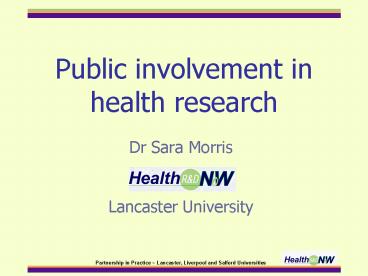Public involvement in health research - PowerPoint PPT Presentation
1 / 19
Title:
Public involvement in health research
Description:
Actively involved in the research process. At any stage in the research process ... FROM: Barnard A et al (2005) Summary of PC11 Report. ... – PowerPoint PPT presentation
Number of Views:37
Avg rating:3.0/5.0
Title: Public involvement in health research
1
Public involvement in health research
- Dr Sara Morris
- Lancaster University
2
What is it?
3
The basics
- Who?
- How?
- When?
- Individuals and/or
- groups
- Actively involved in the research process
- At any stage in the research process
4
Terminology
- Consumer
- Supermarket connotations
- Implies choice (Telford et al, 2002)
- Service user and carer
- Lay researcher / Co-researcher
- Past patients, non-patients, their friends and
families
5
The Public
- Members of the public and people who use services
- make a distinction between those who are
professionally engaged in health or social care
research, and those who are ultimately end users
of research in health and social care (INVOLVE)
6
Types of involvement
- Ownership
- Controlled by lay people
- Collaborative
- Active partners
- Consultative
- Opinions and views of lay people canvassed
- Passive
- Lay support, but not involved
7
Users can be involved
- at the policy level
- Improving the way
- decisions are made about what should be a
priority for research - research is commissioned (chosen and funded)
- at the research level
- Improving the way
- research is carried out
- research findings are communicated
- at the governance level
- Improving the way
- the quality and relevance of research is
monitored
8
Why do it?
9
Should be involved UK policy
- 2.2.6 Relevant service users and carers or their
representative groups should be involved wherever
possible in the design, conduct, analysis and
reporting of research - Research Governance Framework (ed.2 2005)
10
Theoretical reasons
- Ethical
- Relevance to community
- Methodologically helpful
- Pleasure
- Ideally, members of the public should be
- equal partners regarding the major decisions
taken about the research and the whole research
process, with the research focus being driven by
users concerns. (Ramon, 2003 18)
11
Is this a good idea?
- Often seen as unproblematic but can be
contentious - Do ill people want to be involved? yes, but on
their own terms (Beresford) - emphasises the interdependent status of service
users as citizens requiring assistance but with
the right to autonomous decision making (Barnes
Walker 1996 379) - More time and effort needed to do it properly
- May need to adjust attitudes be open to change
12
The effects of lay involvement
- Changes to research questions were made
- New or revised questionnaires, interview designs
etc. - New ways of collecting data
- Able to include many more people to provide data
- Explanations of data related directly to how
people experience the delivery of services - Use of networks to tell other people about
findings - Finding ways to change services, based on the
research findings, and in measuring those changes
- Increased the number of service users/carers in
research - FROM Barnard A et al (2005) Summary of PC11
Report. An evaluation of consumer involvement in
the London Primary Care Studies Programme.
INVOLVE
13
Some primary care examples
- Community engagement projects
- Halton PCT Health history project
- Skelmersdale Stronger, safer communities
- Service evaluation/development
- Chesterfield PCT Evaluation of a nurse-led unit
- Blackburn South Asian Women and Post Natal
Depression - PPI work (user led)
- Cumbria The Needs and Wants of Older People from
the NHS - Blackpool Carer Survey for Cardiac Patients and
their Carers
14
How to do it?
15
Things to think about
- Who to get involved
- General or specific service users?
- Where to find them
- Pre-existing groups and organisations
- Advertise
- How to get them involved
- Develop a relationship with them
- Be very clear about what they can expect
- Ask people about how and when they would like to
be involved
16
Getting started
- I simply suggest that you get involved with
outside groups even if you are not doing any
research just now. In this way you will build up
fruitful relationships and generate wonderfully
rich insights into healthcare issues, or issues
affecting healthcare, well before the genesis of
any research exercise. - (Earl-Slater, 2004 30)
17
Working together
- Research involvement for both Users and Health
Professionals should offer the opportunity to
create good working relationships through - Clear communication
- Respect for each other
- Willingness to learn
18
Involvement work at
- Workshops
- North West Users Research Advisory Group
- Individual advice and training
- Resource centre
19
Contact details
- Dr Sara Morris
- RD Manager
- Bowland Tower East Lancaster University
Lancaster LA1 4YT - Health RD NoW
- Institute for Health Research
- 01524 592656
- s.m.morris_at_lancaster.ac.uk































